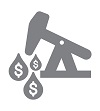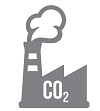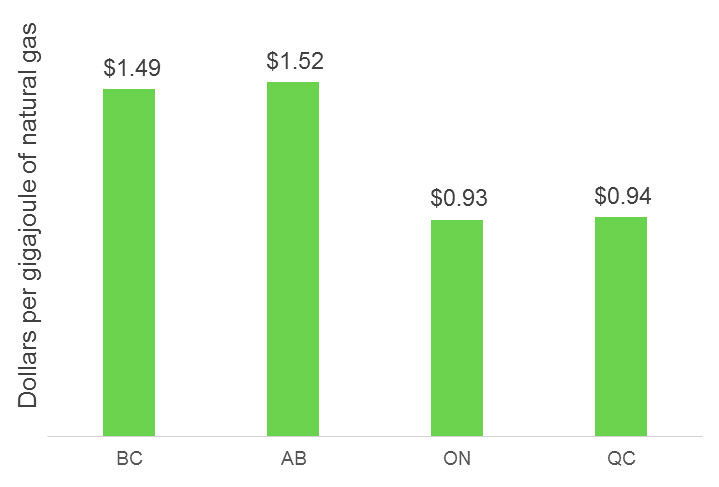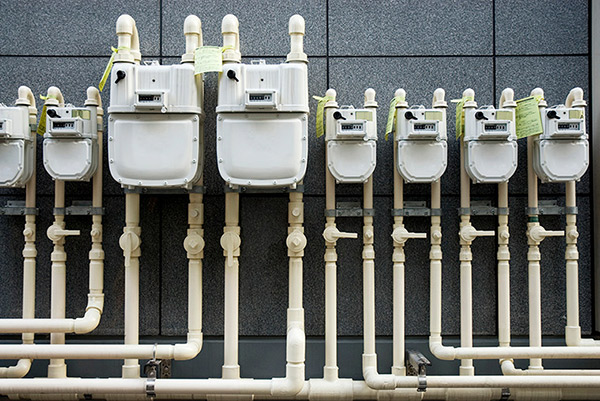Natural gas bills
Residential gas bills vary across Canada. Generally, bills have similar components although they may use different names. The different components recover different costs of supplying natural gas to homes. Some charges are the same for every household no matter how much gas they use. Other charges depend on the amount of natural gas used. Gas bill components usually fit into four categories: commodity price, carbon price (in B.C., Alberta, Ontario, and Quebec), variable charges, and fixed charges.

The commodity price is the price of the natural gas a customer uses. Natural gas providers buy gas at a wholesale price and then resell it to customers. The commodity price can be a regulated rate or a competitive rate. On average, wholesale natural gas prices have generally decreased over the past decade. This is because of increased North American natural gas supply from shale gas production.
Regulated rates are prices approved by a provincial regulator on a periodic basis. This price is based on a forecast of wholesale gas prices. Gas providers selling gas at regulated rates usually do not earn profits on the commodity price.
Competitive rates are prices offered by privately owned companies that compete with each other to sell wholesale natural gas it to customers. Competitive rates are set by each company. Companies offering competitive rates are allowed to make profits on the gas they sell, although they are also at risk of losing money. Competitive rates are available in some provinces where there are many gas retailers competing against each other.

The carbon price is a charge based on the amount of greenhouse gasesFootnote 1 (GHGs) emitted when natural gas is burned. Governments set a carbon price to increase the cost of GHG-emitting fuels like natural gas so less will be consumed and energy use will shift to cleaner sources. Burning one GJ of gas releases about 1/20th of a tonne of CO2. This means the carbon price per GJ of natural gas is approximately the 1/20th of the carbon price per tonne. For example, a carbon price of $30 per tonne of GHGs is approximately $1.5 per GJ of natural gas. Because the amount of emissions is directly caused by the amount of gas used, the carbon price appears on gas bills as a price per unit of gas. As of July 2018, B.C., Alberta, Quebec, and OntarioFootnote 2 have explicit carbon pricing.
Figure 3: Carbon prices as of 1 January 2018

Source: Government of BC, Government of Alberta, OEB, Énergir
Description:
This column chart displays the carbon price per GJ of natural gas as of January 2018. The prices were: BC: $1.49; AB: $1.52; ON: $0.93; QC: $0.94.
 Variable charges collect revenue for costs that depend directly on the amount of gas used. The amount of gas that customers use determines the amount of gas that needs to be moved to their homes. Moving gas is costly. Transportation costs are broken down into transmission costs and distribution costs. Transmission is moving gas from wholesale natural gas markets to a distribution system, for example across one or more provinces. Distribution is delivering gas over shorter distances to individual homes or businesses, for example within a city. Compressor stations pressurize the gas within pipelines to move it. Moving more gas requires more compression, and compressors burn gas to operate. The farther distance and the more volume of gas that is moved, the more gas is burnt for compression.
Variable charges collect revenue for costs that depend directly on the amount of gas used. The amount of gas that customers use determines the amount of gas that needs to be moved to their homes. Moving gas is costly. Transportation costs are broken down into transmission costs and distribution costs. Transmission is moving gas from wholesale natural gas markets to a distribution system, for example across one or more provinces. Distribution is delivering gas over shorter distances to individual homes or businesses, for example within a city. Compressor stations pressurize the gas within pipelines to move it. Moving more gas requires more compression, and compressors burn gas to operate. The farther distance and the more volume of gas that is moved, the more gas is burnt for compression.
The cost of storage also depends on the amount of gas used. Gas storage involves keeping an inventory of gas for later use. Natural gas demand is highly seasonal in Canada because of high heating demand in winter and much lower heating demand in the spring, summer, and fall. To ensure a reliable supply of gas in winter, gas providers often buy extra gas in warmer months and store it so it is available in colder months. This helps ensure that gas is available to customers whenever they need it.
 Fixed charges on a gas bill collect revenue for the costs of items that do not change with the amount of gas used. For example, the cost of the pipelines connected to a home does not change whether a lot of gas or a little bit of gas is used. Other examples include the cost of administration and billing, the cost of the gas meter, and the cost of the distribution systemFootnote 3. Fixed charges are the best way to recover large, infrequent capital costs, such as the cost of building or expanding the pipeline system. For example, a company will spend a large amount of money to build a pipeline system. The company then calculates a charge to bill users of pipeline, from now until the end of the pipeline’s life. All the charges over time should add up to the total cost of the pipeline plus a reasonable rate of return. This means that current, and future users of the pipeline system all pay their share for using it.
Fixed charges on a gas bill collect revenue for the costs of items that do not change with the amount of gas used. For example, the cost of the pipelines connected to a home does not change whether a lot of gas or a little bit of gas is used. Other examples include the cost of administration and billing, the cost of the gas meter, and the cost of the distribution systemFootnote 3. Fixed charges are the best way to recover large, infrequent capital costs, such as the cost of building or expanding the pipeline system. For example, a company will spend a large amount of money to build a pipeline system. The company then calculates a charge to bill users of pipeline, from now until the end of the pipeline’s life. All the charges over time should add up to the total cost of the pipeline plus a reasonable rate of return. This means that current, and future users of the pipeline system all pay their share for using it.
The role of the regulator and the utility providers

Reliable natural gas supply is, in many contexts, an essential service. In cold climates, interruptions to natural gas service can endanger the lives and property of people that rely on it to heat their homes. To ensure reliable and fair natural gas service, provincial regulators oversee the way natural gas providers operate.
Natural gas providers sell natural gas service to customers and arrange for gas to be delivered to their homes. Local distribution companies (LDC) own and operate distribution systems. Retailers sell service to customers but don’t necessarily own the pipelines used. A retailer may contract with a separate LDC to use that LDC’s pipelines or may be part of the same company as the LDC. Sometimes a Crown corporation acts as both retailer and LDC.
Pipelines are typically natural monopolies. This means it is cheaper to have one pipeline system service a region than to have many competing, redundant systems. Because distribution systems are made up of pipelines, an LDC tends to have franchise rights in a particular region. This gives the LDC the rights to do business, and own and operate the distribution system in a region with no competition. To make sure the LDC offers reliable service at a fair price, it must follow rules set by provincial regulators.
Regulators ensure customers pay a fair price for services while the LDCs and retailers earns a reasonable return. Provincial regulators can dictate the way natural gas providers operate. Regulators approve how much a natural gas provider can charge, and what it can charge for. The regulators also make sure that any new pipelines and infrastructure a utility builds will benefit the public. Additionally, regulators ensure that retailers can fairly contract with the LDC that owns the local franchise and the pipeline system to deliver gas.
- Date modified:
